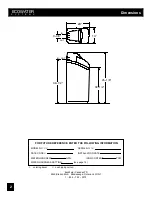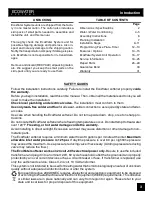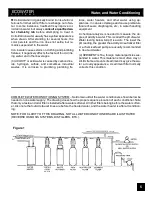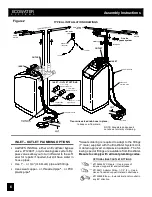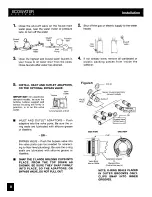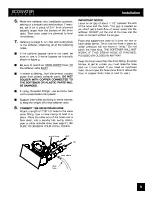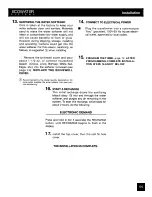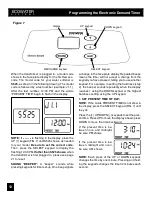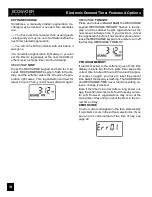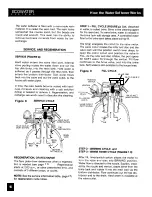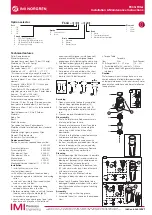
4
ECOWATER
S
Y
S
T
E
M
S
Water, and Water Conditioning
WATER
Man’s very existence depends on water. It is 1 of the
basic commodities of life. Water is best as nature
provides it, is a common misconception. Practically
all natural water needs refinement or treatment to
make it safe to drink or more satisfactory to use.
The earth’s water supply cycle starts in the upper
cloud layers. As it falls to the earth as rain or snow,
it picks up impurities and gases from the atmo-
sphere. Landing on earth, it seeps over and through
the ground, dissolving earth minerals. Passing
through limestone, it dissolves calcium and magne-
sium, the hardness minerals. Iron deposits impart
iron to the water. Acidity and sediments are other
water conditions.
Municipal water supplies come from surface reser-
voirs, such as lakes and rivers, or from underground
reservoirs. Usually, municipalities chlorinate the wa-
ter to make it safe to drink. Sediment is removed by
filtration. Tastes and odors are reduced or elimi-
nated. The water is conditioned to comply with cer-
tain specifications. However, hardness minerals,
tastes and odors are not always reduced to the most
desirable levels.
Underground reservoirs provide our private water
supplies. Because the water is raw and untreated, it
can have varying amounts of hardness, iron, tastes,
odors, acidity, or combinations of these. Different lo-
calities and water levels affect mineral content.
WATER CONDITIONING
Water conditioning is the treatment of four general
conditions. These are: (1)
Hardness
, (2)
Iron
, (3)
Acidity
, (4)
Sediments
.
(1)
HARDNESS
is a term to describe the presence
of calcium and magnesium minerals in water. A
chemical analysis accurately measures the amount
of minerals in grain weight. For example, 1 gallon of
water with 5 grains per gallon (gpg) hardness has
dissolved minerals, that if solidified, about equals
the size of 1 ordinary aspirin tablet. One gallon of wa-
ter, 25 gpg hard, has a mineral content equal in size
to 5 aspirin tablets. Water hardness varies greatly
across the country. It generally contains from 3 to
100 gpg.
Hard water affects living in general. Hardness miner-
als combine with soap to make a soap curd. The
curd greatly reduces the cleaning action of soap.
Precipitated hardness minerals form a crust on
cooking utensils, appliances, and plumbing fixtures.
Even the tastes of foods are affected. A water soft-
ener removes the hardness minerals to eliminate
these problems, and others. Pages 16--17 describe
how the EcoWater conditioner works.
Sodium Information: Water softeners using sodium
chloride (salt) for regeneration add sodium to the
water. Persons on sodium restricted diets should
consider the added sodium as part of their overall in-
take.
(2)
IRON
in water is measured in parts per million
(ppm). The total* ppm of iron, and type or types*, is
determined by chemical analysis. Four different
types of iron in water are:
❶
Ferrous (clear water),
❷
Ferric (red water),
❸
Bacterial and organically
bound iron,
❹
Colloidal and inorganically bound iron
(ferrous or ferric).
*Water may contain one or more of the four types of
iron and any combination of these. Total iron is the
sum of the contents.
❶
Ferrous (clear water) iron is soluble and dissolves
in water. It is usually detected by taking a sample of
water in a clear bottle or glass. Immediately after tak-
ing, the sample is clear. As the water sample stands,
it gradually clouds and turns slightly yellow or brown
as air oxidizes the iron. This usually occurs in 15 to
30 minutes. An EcoWater conditioner will remove
moderate amounts of this type of iron*.
*Capacity to remove clear water iron was tested in
the field by the manufacturer.
❷
Ferric (red water), and
❸
Bacterial and organically
bound irons are insoluble. This iron is visible immedi-
ately when drawn from a faucet because it has oxi-
dized before reaching the home. It appears as small
cloudy yellow, orange, or reddish suspended par-
ticles. After the water stands for a period of time, the
particles settle to the bottom of the container. Gener-
ally these irons are removed from water by filtration.
Chlorination is also recommended for bacterial iron.
An EcoWater conditioner will remove minimal quan-
tities (see specifications) of ferric iron.
continued


